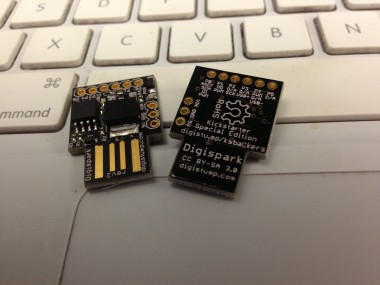
Say hello to my little friend!
This is the Digispark: “The micro-sized, affordable, Arduino enabled, usb development board.” This board has 6 I/O lines, which doesn’t sound like much, until you consider that it supports I2C, which is a 2-wire serial bus capable of addressing many peripherals at once.
This is my first venture into Arduino-land, and I’m still climbing the learning curve. But I have many ideas for projects, and I’m sure that more will occur to me as I get deeper into the system. It’s been a long time since I got to play around with DIY electronics but it’s something I used to enjoy a lot.
I haven’t had much time to play with them yet, just enough to try some of the example code, blinking the on-board status LED, and programming it to act as a keyboard or mouse. The main hurdle I’m trying to get over right now is to communicate with it over USB through nodejs. I found the node-hid module, and I’m able to see the Digispark and read its USB product info, but I haven’t been successful at actually reading/writing my own messages to it yet. Once I get past that, I will be able to send commands to it in real-time, which will be more interesting when I get it hooked up to some other sensors and devices.
Eventually, I’d like to get some remote communications modules (WiFi or Bluetooth), so that it can be a stand-alone device that I can interact with remotely. I should be able to build some simple robots, for example.
I hope to post more about it soon, assuming I can find time to make something interesting. If anybody else is playing with the Digispark and nodejs, I’d be particularly interested in hearing from you. Once I get some test code working, I’ll put it up on Github.

Pingback: Node-Red – Digispark RGB Node – Ben's Place